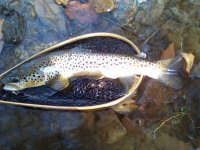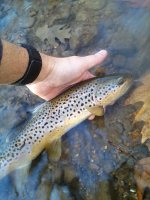klingy
Active member
- Joined
- Jul 31, 2010
- Messages
- 591
I like to walk along trout streams in the fall. I often will take short walks to check out spots that I've never fished before to poke around, check for redds, look for fish, or just to have an excuse to get outside. Today I had a couple hours so I checked out a section of the Breeches that I had only fished once or twice before. It is miles downstream of where I usually fish, and I was really looking to see if there was much evidence of wild trout that far downstream. I wasn't going to bring my rod, but at the last second I threw it in the car.
When I got to the stream, I brought the rod thinking I probably wasn't going to use it, but just in case. I walked a few hundred yards of stream on the bank, and actually counted 12 redds, all of which the fish had moved on from. Interesting. Well, while I was there, I should at least throw a couple in.
I didn't have anything with me besides what was rigged from the last time I was out in October - a Letort Hopper with a PT nymph dropper. I stayed close to the bank and worked a run of about 3 feet of water with no redds in the area. Second cast, the hopper went under. A beautiful 12 inch wild brown. Bonus!, I thought. A few casts later, a 6 incher. Took a few steps towards a big sycamore, and drifted a few past a cut under the tree. On the third cast, there was an explosion. A big brown porpoised out of the water and destroyed the hopper. Game on! After a few nice runs and jumps, I landed it. Really interesting fish - had a lot of signs of a wild fish (clean, crisp fins, blue eye spot), but its spotting makes me suspect maybe an old holdover? In either case, this will be a spot that I come back to in the future, and it was a good reminder to get out and take a walk along a stream in the fall. You never know what you'll find!
When I got to the stream, I brought the rod thinking I probably wasn't going to use it, but just in case. I walked a few hundred yards of stream on the bank, and actually counted 12 redds, all of which the fish had moved on from. Interesting. Well, while I was there, I should at least throw a couple in.
I didn't have anything with me besides what was rigged from the last time I was out in October - a Letort Hopper with a PT nymph dropper. I stayed close to the bank and worked a run of about 3 feet of water with no redds in the area. Second cast, the hopper went under. A beautiful 12 inch wild brown. Bonus!, I thought. A few casts later, a 6 incher. Took a few steps towards a big sycamore, and drifted a few past a cut under the tree. On the third cast, there was an explosion. A big brown porpoised out of the water and destroyed the hopper. Game on! After a few nice runs and jumps, I landed it. Really interesting fish - had a lot of signs of a wild fish (clean, crisp fins, blue eye spot), but its spotting makes me suspect maybe an old holdover? In either case, this will be a spot that I come back to in the future, and it was a good reminder to get out and take a walk along a stream in the fall. You never know what you'll find!






